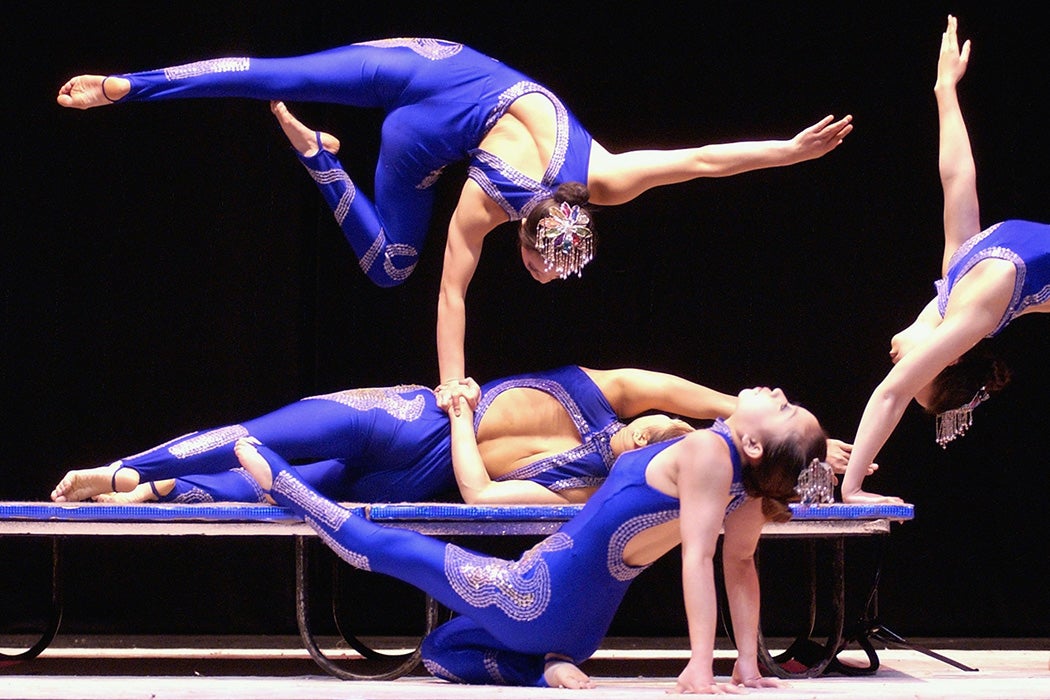Since the late 1980s, Chinese acrobats have been amazing millions of audience-goers in Canada and the United States. Up to the early 2000s, more than a thousand Chinese acrobats worked as performers for North American companies. By 2010, 20 percent of the performers working for the Canadian entertainment giant Cirque du Soleil were Chinese.
So how did a popular Chinese entertainment form, transformed into a socialist performance/propaganda art during the early People’s Republic, become what scholar Tracy Y. Zhang called, “one of China’s most profitable cultural exports to North America”?
Zhang examines the transnational “politics of aesthetic labor” that led to the recruitment of Chinese acrobats as temporary foreign workers. Acrobats usually aren’t thought of as guest workers, but they are. Legally, Canadian companies aren’t required to obtain work permits for non-Canadian artists who work in Canadian-owned foreign touring productions. And the US’s P-1B cultural worker visa is, as Zhang writes, “especially flexible for recruiting non-US circus performers.”
“It is very easy for North American companies to hire foreign artists under short-term contracts,” she writes. “However, foreigners, especially those who work for international touring shows, have difficulty using the Canadian and US legal system to defend their labor rights.”
It’s long been a practice to import “skilled workers from low-income countries,” Zhang explains, particularly in the agriculture and manufacturing sectors. The US, for instance, has a long history of first recruiting immigrant farm workers and then turning against them. The demand for workers in public health, domestic work, and hospitality has also influenced immigration policies. Importing workers for purposes of entertainment is a newer aspect of international labor commodification and exploitation.
Former socialist countries like China, Russia, Ukraine, and Mongolia have all exported “skilled acrobats, contortionists, gymnasts, and other physical arts professionals.” This is a legacy of the state sponsorship of the arts, culture, and sports in those countries. Acrobats and gymnasts were given priority and prestige under these regimes, especially when it came to Cold War competition in the Olympics and cultural offensives.
The situation of Chinese acrobats is complicated by the fact that it’s the Chinese government that signs the labor contract with the North American entertainment companies, not the workers themselves. The “language barrier and limited access to legal experts” has made such guest workers particularly vulnerable to exploitation.
The Chinese acrobats Zhang interviewed were all paid below minimum wage.
Historically, acrobats were important figures in China’s cultural efforts following the foundation of the People’s Republic in 1949. “As part of international exchange activities, acrobats used their agile bodies to communicate the ideas of ‘Chinese people’ and ‘friendship’” around the world, writes Zhang. This produced “particular kinds of acrobatic bodies for displaying China’s ideal citizen subject and national character at home and abroad.” (Pandas were also used as propaganda tools.)
After China was admitted to the UN in 1971, acrobatics was chosen to be the “cultural tool with which to build relationships with the West.” North American circus companies took notice of the popularity of such events as the Shenyang Acrobatic Troupe’s 1972 tour, which received rave reviews in the US and Canada and was filmed for television.
Weekly Newsletter
Zhang profiles Jiang Zhenping, who started with the Shanghai Acrobatic Troupe in 1960, when he was twelve. His troupe toured Western Europe and Japan in the 1970s and North America in 1980, the year that marks the beginning of “China’s profit-orientated export of acrobats.” In 1987, he was working for Ringling Bros. and Barnum & Bailey Circus, in a performance that the circus’s owner described as representing the “mystery and magic of the Orient.” Surrounded by pigtails, Fu Manchu mustaches, and the expectation that he would know marital arts like Bruce Lee, Zhenping “found Americans’ ideas about China absurd.”
Zhang also interviewed Wang Junru, who started circus school at the age of four in China. She started working for Cirque du Soleil at nine and made about $5,000 a year for five years. In 2012, after her lonely and stressful North American temp gig was done, she won Season Four of China’s Got Talent.
Support JSTOR Daily! Join our membership program on Patreon today.







